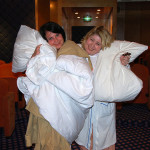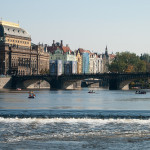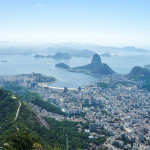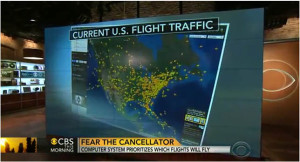-by Erin
Flights with layovers are often cheaper than direct flights, but despite the savings, many travelers will pay more to avoid the extra time in the airport. Can we blame them? The thought of sitting around in an airport for six hours is only vaguely more enticing than a dental appointment. And who would want to prolong their travel time more than necessary, especially when beach side hotel in Hawaii or a South American New Years cruise awaits at the end of the journey?
But despite their reputation as a necessary evil, layovers don’t have to mean endless hours of watching the clock and waiting for your Amazing Journey to start. In fact, a layover can be a memorable part of your trip and, dare we say it, fun. Instead of killing time filling out crossword puzzles and browsing the bookstore (there are only so many hours you can spend flipping through magazines you haven’t purchased before you’re asked to leave), why not dine on dishes created by celebrity chefs, take a mini-excursion to a local city or burn some calories in a fitness center?
Leave the Airport, See the Sights
Airports that offer fast and affordable transportation to the cities they serve are the best places for an airport layover adventure. In cities like Amsterdam, Sydney, Washington D.C., Chicago and London, travelers can easily take public transportation from the airport to the city center and spend a half-day exploring.
For best results, sketch out a rough itinerary ahead of time. Find out what kind of transportation you’ll need to take to and from the airport (most airport Web sites list this information) and research the locations of attractions you want to visit. You may want to focus on a single attraction or neighborhood to save travel time. Allow plenty of wiggle room for traffic, long airport security lines and other variables.
Work Out
If you’re not shy about folding into downward dog in public, pack a yoga mat and work on your positions at the airport. A few minutes of deep breathing and stretching is a fantastic way to get your blood flowing after a flight. Check your airport’s Web site to see if it offers a yoga or fitness area. Singapore’s Changi Airport has a gymnasium where you can do a few stretches (for a fee), while Amsterdam’s Schiphol Airport has a meditation center that’s available to travelers at no cost. The quiet corner of an airport lounge also works as a suitable place to do some yoga if your airport doesn’t offer an appropriate facility.
Want to get some cardio in during your layover? AirportGyms.com is a useful Web site where you can search for fitness centers in or around airports in the U.S. and Canada. If there’s no gym in your airport, stuff some sweats into your carry-on bag and go for a jog around the terminals. This is best to do at an airport that offers shower facilities — be considerate of the person who will have to sit inches away from your sweaty armpits on the next flight.
Sleep
Some travelers think sleeping in the airport is disturbingly analogous to sleeping on the street (especially during an overnight layover), while others have no qualms about catching some Z’s on a terminal bench. One’s comfort level depends on a number of factors, from personal experience to conditions in the airport in which you’re staying. Many airports have designated sleeping sections or special sleep chairs that make for painless napping. Hong Kong International Airport, South Korea’s Incheon International Airport and Vancouver International Airport are a few major hubs that offer comfy lounge chairs and padded benches on which travelers can fully stretch out.
If you’re planning to spend the entire night on an airport bench, you may be awakened by airport security guards who aren’t fond of travelers setting up camp in public, depending on what airport you’re snoozing in. Stay overnight in the airport at your own risk.
Get a Room
Your eyes are heavy after a seven-hour red eye, but you don’t like the idea of dozing off in public. There’s a solution. Consider paying for short-term lodging, even if it’s for a layover that’s only a half-day or so long — it may be cheaper than you think and well worth the cost.
London Heathrow, London Gatwick and Amsterdam Schipol airports all have YOTEL facilities, which are accommodations within the airport terminals inspired by Japanese capsule hotels. A standard cabin can be rented for a minimum of four hours, and comes with a bathroom with shower, a bed, a fold-out desk and a flat-screen TV (all amazingly squeezed into seven square meters).
To get the cheapest rate at an airport hotel, plan ahead as opposed to showing up and requesting a room on the spot. Check rates online for airport hotels before you leave for your trip, and keep an eye out for special rates and other offers. On Hotels.com, we found rates at the Days Inn Airport Best Road, located just 1,600 yards from Hartsfield-Jackson Atlanta International Airport, for $47 per night plus taxes, including free shuttle service to and from the airport — which is arguably a reasonable price to pay for a few hours of peace and quiet during a layover.
Play a Game
Pack one or two board games in your carry-on and get your travel companion or a friendly stranger waiting in your terminal to join in on the fun. Computer solitaire doesn’t count; get your face away from that computer screen for half an hour and engage with a real human being — it’s a great way to pass the time. Some good, packable games include Bananagrams, Travel Scrabble and Yahtzee To Go.
Chat with a Stranger
Chatting it up with an approachable stranger at the airport bar, in the lounge or in a restaurant could lead to a short, dull conversation at worst and a fascinating glimpse into a fellow traveler’s experiences at best. Talk to someone waiting near your gate; odds are you’ll both be heading to the same place. If the person is a local or a repeat visitor to your destination, your chat could yield a wealth of valuable vacation tips.
Eat Like a King
Airport food is notoriously bad, but there are definitely some exceptions to this rule. Select airport eateries offer genuine gourmet cuisine, from locally inspired classics to luxurious dishes. Stranded in JFK? Skip the KFC Express and head to La Vie, a French cafe that serves sophisticated fare like sauteed prawns Provencal and sole meuniere. There’s a popular Legal Sea Foods restaurant at Boston Logan Airport where travelers can get the same fresh fruits de la mer as those served downtown.
On the international front, celebrity chef Gordon Ramsay recently set up shop in at London’s Heathrow Airport with a Michelin-starred restaurant cleverly called Plane Food. Travelers in a hurry can pick up a Plane Food “picnic” in a portable shoulder bag and bring their gourmet meal on the plane (warning: may cause jealous seatmates).
Play an Instrument
The guy who led stranded travelers in a sing-along at Newark Airport became a hero for the moment (and a YouTube sensation) when he saved dozens of passengers from their momentary boredom with his trusty guitar. Entertain yourself and others around you by packing your instrument and playing some tunes. If you’re especially talented, perform next to an upturned hat and use the proceeds to cover your baggage fees.
People Watch
Lots of big cities are famed for their people watching opportunities. In particular, New York comes to mind, and there’s even an amusing Web site, OverheardinNewYork.com, that features snippets of conversation from around the Big Apple. I haven’t found an airport version of this site, but I bet it would be a fabulous read.
With their hodgepodge of interesting characters from every corner of the globe rushing about, airports are the perfect places to conduct casual anthropological research. You’re in a public place, so there’s nothing wrong with eavesdropping on a loud conversation or taking a second look at the 20-something anarchist with tear-drop tattoos on his face. Share the interesting things you see and hear on Facebook (we’d love to read about them).
Original source: Independent Traveler




























